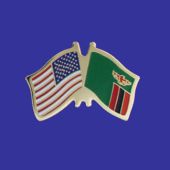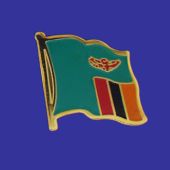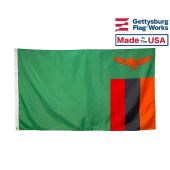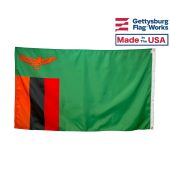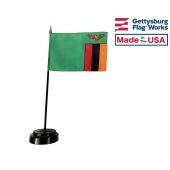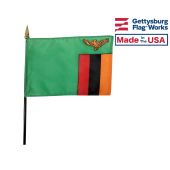Flag of Zambia
Flag of Zambia
The modern flag of Zambia is only twenty years old, but a similar design has been in use since the nation first gained its independence from the British Empire in the middle of the 20th century. The times when Zambian flags can be flown within the nation are restricted by law, but the flag remains a potent symbol of the Zambian nation and its people.
The flag of Zambia, adopted on October 24, 1964, is green with orange colored eagle in flight over a rectangular block of three vertical stripes, colored, from left to right: red, black and orange. The placement of the eagle and block of stripes at the flag's fly is unique as most emblems and devices on flags are placed at center or at the hoist. The colors used in the flag of Zambia are rich in symbolism. Green stands for the nation's lush flora, red for the nation's struggle for freedom, black for the Zambian people, and orange for the land's natural resources and mineral wealth. Additionally, the eagle flying above the colored stripes is intended to represent the people's ability to rise above the nation's problems.
The Zambian flag was slightly modified in 1996. The shade of green used in the 1964 flag was substituted for a brighter and lighter green and the eagle was slightly altered so as to be more like the one used in the Zambian coat of arms. The flag was designed by Mrs Gabriel Ellison, OGDS, MBE, who also designed the national coat of arms and many of Zambia's stamps.
- Capital of Zambia: Lusaka
- Area of Zambia: 740,724 sq. km
- Languages used in Zambia: English (official), Bemba, Kaonda, Lozi, Lunda, Luvale, Nyanja, Tonga, 70 other indigenous languages
- Religions in Zambia: Christian, Muslim and Hindu, indigenous beliefs
Colors and Symbolism of Zambian Flags
Zambia flags feature a solid green field with an orange eagle in flight over three vertical stripes of red, black, and orange in the fly. Each part of the flag of Zambia also represents an aspect of the country and its people. The flying eagle represents the ability of the Zambian nation and people to rise above their problems in the pursuit of a better future. Each color on the flag also has symbolic value. The green field represents the rich natural world of Zambia, the red stripe represents freedom and the nation's efforts to attain it, the black bar represents the people of Zambia, and the orange bar represents the nation's resources and wealth.
History of the Flag of Zambia
The earliest Zambian flags come from the colonial period, starting when the nation was ruled by the British South Africa Company in 1890. The company with a variant on the British Union Jack that featured a white disc with the company's emblem in the center. The emblem was a lion grasping an elephant's tusk, which represented a major part of the company's income.
Zambia eventually became a full British colony rather than part of the British South Africa Company's holdings, and it gained a new flag during the transition. The new flag resembled those of other British colonies. It was a British blue ensign that featured the Union Jack in the flag's canton and the Zambian coat of arms in the fly. The coat of arms included the soaring eagle that is used on modern Zambia flags. This flag came into use in 1924.
The colony eventually became part of the federation of Rhodesia and Nyasaland, which had a colonial flag of its own. The flag came into use in 1953 and represented Zambia until it gained its independence in 1963.
Zambia's first flag as an independent nation differed from the current flag only in that the field was a darker shade of green and used a slight variation on the eagle emblem. It was replaced by the modern flag in 1996.
